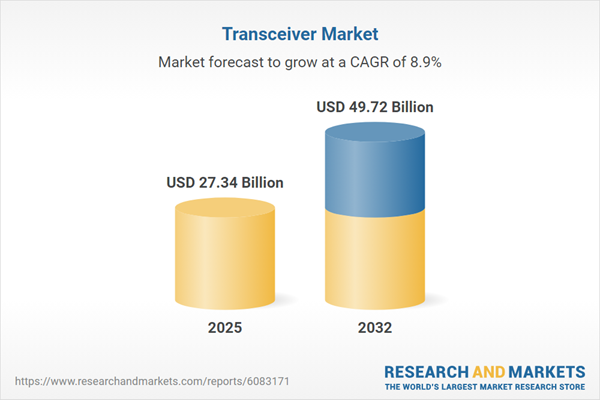Speak directly to the analyst to clarify any post sales queries you may have.
The transceiver market is undergoing significant transformation, with rapid digitalization and next-generation networking catalyzing advances in fiber optic technologies. Senior executives require a data-driven perspective on shifting supply chain, technology integration, and regional investment landscapes to make informed decisions in this expanding sector.
Market Snapshot: Optical Transceiver Market Size and Growth
The transceiver market grew from USD 25.05 billion in 2024 to USD 27.34 billion in 2025. It is expected to continue growing at a CAGR of 8.94%, reaching USD 49.72 billion by 2032.
This expansion aligns with sustained increases in bandwidth demand driven by cloud computing, 5G infrastructure, and digital transformation initiatives across industries. The strong market trajectory highlights the central role of optical transceivers as essential components in modern connectivity, supporting scalable data transport and network evolution.Scope & Segmentation
This report provides an expansive analysis of the transceiver ecosystem, breaking down market opportunities by technology, application, and regional focus:
- Form Factors: Cfp, Cfp2, Cfp4, Qsfp+, Qsfp28, Qsfp56, Sfp, Sfp+, Sfp28
- Data Rates: 1Gbps, 10Gbps, 25Gbps, 40Gbps, 100Gbps, 200Gbps, 400Gbps, 800Gbps
- Wavelength Types: Multimode, Single Mode
- Transmission Modes: Cwdm, Dwdm, Wdm
- Applications: Data Center, Enterprise, Industrial, Telecom
- End Users: Cloud Service Providers, Enterprises, Hyperscale Data Centers, Telecom Operators
- Reach: Access, Short Haul, Metro, Long Haul
- Connector Types: Lc, Mpo, Sc
- Regions: North America (United States, Canada, Mexico), Latin America (Brazil, Argentina, Chile, Colombia, Peru), Europe (United Kingdom, Germany, France, Russia, Italy, Spain, Netherlands, Sweden, Poland, Switzerland), Middle East (United Arab Emirates, Saudi Arabia, Qatar, Turkey, Israel), Africa (South Africa, Nigeria, Egypt, Kenya), Asia-Pacific (China, India, Japan, Australia, South Korea, Indonesia, Thailand, Malaysia, Singapore, Taiwan)
- Key Companies: Analog Devices, Broadcom, NXP Semiconductors, Texas Instruments, Infineon Technologies, Intel, Qualcomm, Skyworks Solutions, Qorvo, MediaTek, Semtech, MaxLinear, Microchip Technology
Key Takeaways: Strategic Insights for Senior Decision-Makers
- Optical transceivers are driving the modernization of enterprise and hyperscale network infrastructures by enabling efficient high-speed data transfer and supporting network scalability.
- Technology developments such as silicon photonics, digital signal processing, and coherent optics are fostering greater integration, power efficiency, and adaptability, which support diverse application scenarios.
- The increasing adoption of edge computing and cloud services is fueling demand for ruggedized and compact transceiver modules that can operate effectively in distributed and challenging environments.
- Collaboration among manufacturers, integrators, and service providers, supported by open standards, is fostering an ecosystem of interoperability that accelerates network rollout and operational flexibility.
- Supplier strategies now prioritize rapid lifecycle upgrades, robust reverse logistics, and end-to-end service offerings to enhance customer engagement and maintain operational reliability.
- Regional investment dynamics reflect both infrastructure readiness and targeted public-private partnerships, with Asia-Pacific notably emerging as a hub for technology innovation and manufacturing capacity.
Tariff Impact: Evolving Supply Chains and Cost Structures in 2025
Expanded tariff schedules in 2025 have redefined sourcing, manufacturing, and procurement strategies for transceivers, particularly within the United States. Organizations are increasingly turning to nearshoring and regional assembly to alleviate tariff pressures, while multi-sourcing and strategic supplier alliances are strengthening supply resilience. These industry responses not only address cost fluctuations but have also spurred localized innovation, prompting vendors to pursue advanced semiconductor processes and reduced component dependencies to maintain competitiveness.
Methodology & Data Sources
The analysis combines exhaustive secondary research—regulatory filings, industry reports, and public disclosures—with in-depth interviews of telecom, enterprise, and cloud infrastructure leaders. Quantitative models evaluate supply chain and cost structures, while qualitative assessments from expert workshops validate strategic technology adoption trends.
Why This Report Matters
- Delivers actionable intelligence for risk management, technology planning, and investment prioritization in the optical transceiver market.
- Provides a comprehensive segmentation and competitive landscape overview to inform procurement, partnership, and policy strategies.
- Enables benchmarking against industry innovation and supply chain best practices for sustained value creation and agility.
Conclusion
This report supplies leadership with in-depth, segmented insights and the latest industry intelligence. Consider its findings to guide strategic initiatives, enhance network resilience, and seize growth opportunities in the evolving transceiver market.
Table of Contents
3. Executive Summary
4. Market Overview
7. Cumulative Impact of Artificial Intelligence 2025
Companies Mentioned
The companies profiled in this Transceiver market report include:- Analog Devices, Inc.
- Broadcom Inc.
- NXP Semiconductors N.V.
- Texas Instruments Incorporated
- Infineon Technologies AG
- Intel Corporation
- Qualcomm Incorporated
- Skyworks Solutions, Inc.
- Qorvo, Inc.
- MediaTek Inc.
- Semtech Corporation
- MaxLinear, Inc.
- Microchip Technology Inc.
Table Information
| Report Attribute | Details |
|---|---|
| No. of Pages | 195 |
| Published | November 2025 |
| Forecast Period | 2025 - 2032 |
| Estimated Market Value ( USD | $ 27.34 Billion |
| Forecasted Market Value ( USD | $ 49.72 Billion |
| Compound Annual Growth Rate | 8.9% |
| Regions Covered | Global |
| No. of Companies Mentioned | 14 |









